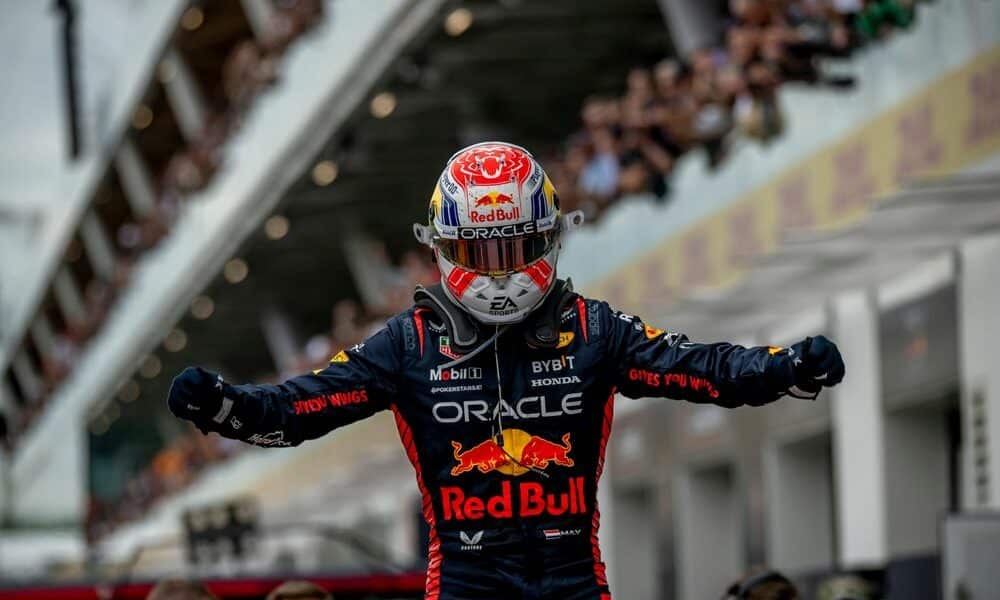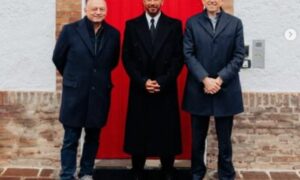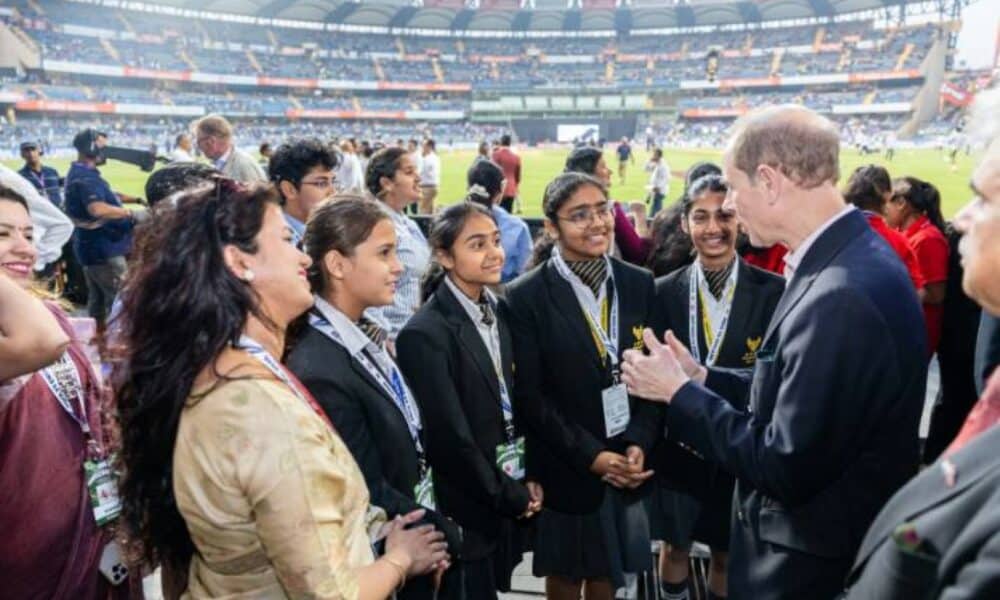Verstappen Leads with $65 Million, Hamilton in Second
The salaries of Formula 1 drivers continue to reach impressive figures in 2025. In a sport where performance and marketing go hand in hand, teams invest millions to ensure their top talents remain on the grid. Max Verstappen, a four-time world champion, leads the list of highest-paid drivers, earning a base salary of $65 million per year. The Dutchman has solidified himself as one of the greatest names in the category, and his presence at Red Bull is considered essential for the team’s success. Right behind him, Lewis Hamilton, who switched from Mercedes to Ferrari, has a contract worth $60 million per year, maintaining his status as one of the most valuable drivers.
In addition to the two leaders, Charles Leclerc ranks third on the salary list, with a $34 million contract secured until 2028. Other big names on the grid, such as Fernando Alonso and Lando Norris, round out the top five highest earners, with salaries of $20 million each. It is important to note that these figures refer only to the fixed contracts paid by the teams, not including sponsorships and performance bonuses, which can further increase the drivers’ annual earnings.
The driver market has seen intense movements in recent years, leading to significant salary adjustments. Hamilton, for instance, left Mercedes after more than a decade to join Ferrari, while Carlos Sainz moved from the Italian team to Williams, where he signed a $10 million contract until 2027.
From race victories to championship titles, a huge thanks to those of you who raced with me this year in @EASPORTSF1 #F124 🏁 pic.twitter.com/03SONDcwGH
— Max Verstappen (@Max33Verstappen) December 29, 2024
The Highest-Paid Drivers in Formula 1 in 2025
The salaries in Formula 1 vary according to performance, history, and the ability to attract sponsors. Below is a list of the highest salaries in the category this season:
- Max Verstappen (Red Bull) – $65 million (€59 million) – contract until 2028
- Lewis Hamilton (Ferrari) – $60 million (€55 million) – contract until 2026
- Charles Leclerc (Ferrari) – $34 million (€31 million) – contract until 2028
- Fernando Alonso (Aston Martin) – $20 million (€18 million) – contract until 2026
- Lando Norris (McLaren) – $20 million (€18 million) – contract until 2026
- George Russell (Mercedes) – $15 million (€13.5 million) – contract until 2025
- Carlos Sainz (Williams) – $10 million (€9 million) – contract until 2027
- Pierre Gasly (Alpine) – $10 million (€9 million) – contract until 2026
The Impact of the Driver Market on Salary Negotiations
Hamilton’s move to Ferrari completely changed the team’s internal balance. With a $60 million salary, the British driver has become the Scuderia’s main bet for the coming years, sharing responsibilities with Leclerc. This move also had direct effects on Mercedes, which placed George Russell as its new team leader, opening space for a future new talent.
Another major change was Carlos Sainz’s transfer to Williams. With a contract valid until 2027 and an annual salary of $10 million, the Spanish driver became one of the leading figures in the team, which aims to rebuild its competitiveness in the grid. This negotiation reflects the teams’ strategy of balancing investment and sporting returns.
The Role of Sponsors in Drivers’ Earnings
Beyond team salaries, Formula 1 drivers significantly increase their earnings through sponsorship deals and commercial agreements. Max Verstappen, for example, has contracts with brands such as EA Sports, Heineken, and Viaplay, which add millions to his annual income. Meanwhile, Lewis Hamilton, who has always been one of the most recognizable faces in motorsport, maintains deals with global companies that further increase his earnings.
Sponsorships play a fundamental role in the Formula 1 economy. Brands seek to associate with the top drivers for visibility, and the most successful competitors become influential figures in the global market. This also helps justify the high salaries offered by teams.
The Salary Gap Among Drivers on the Grid
Despite the multimillion-dollar figures paid to top drivers, there is a significant disparity between the contracts of leading teams and those offered by smaller teams. While Verstappen and Hamilton earn over $60 million a year, some rookies receive significantly lower salaries. Below are some of the lowest-paid drivers this season:
- Gabriel Bortoleto (Sauber/Audi) – $2 million (€1.8 million) – contract until 2027
- Yuki Tsunoda (Racing Bulls) – $2 million (€1.8 million) – contract until 2025
- Kimi Antonelli (Mercedes) – $2 million (€1.8 million) – contract until 2025
- Oliver Bearman (Haas) – $1 million (€900,000) – contract until 2027
- Jack Doohan (Alpine) – $500,000 (€450,000) – contract until 2026
The entry of new talents into Formula 1 directly impacts salary values, as teams prefer to invest in promising drivers with lower salaries before renegotiating more substantial contracts in the future.
The Influence of the Cost Cap in Formula 1
In recent years, Formula 1 has implemented a cost cap to balance team finances. This limit directly impacts driver contracts, as teams must distribute their investments between car development, infrastructure, and salaries. Ferrari, for example, had to reorganize its financial structure to accommodate Hamilton and retain Leclerc, ensuring that both felt valued within the team.
Budget restrictions also explain why some teams opt to offer longer contracts at lower values, betting on developing new talents rather than spending massive amounts on veteran drivers.
The Rising Value of Drivers and the Future of F1 Contracts
Formula 1’s global growth, driven by streaming platforms and social media, has turned drivers into global celebrities. This has further increased the demand for million-dollar contracts, as athletes now represent not only their teams but also international brands.
In the coming years, the market is expected to remain active, with even more strategic negotiations. Lando Norris, for example, could become one of the next drivers to receive a significant salary increase if he continues his upward trajectory at McLaren.
The Formula 1 salary landscape shows that drivers’ earnings reflect not only their performance on the track but also their commercial value. The market is more dynamic than ever, and teams continue to invest heavily to secure the best talents available.

The salaries of Formula 1 drivers continue to reach impressive figures in 2025. In a sport where performance and marketing go hand in hand, teams invest millions to ensure their top talents remain on the grid. Max Verstappen, a four-time world champion, leads the list of highest-paid drivers, earning a base salary of $65 million per year. The Dutchman has solidified himself as one of the greatest names in the category, and his presence at Red Bull is considered essential for the team’s success. Right behind him, Lewis Hamilton, who switched from Mercedes to Ferrari, has a contract worth $60 million per year, maintaining his status as one of the most valuable drivers.
In addition to the two leaders, Charles Leclerc ranks third on the salary list, with a $34 million contract secured until 2028. Other big names on the grid, such as Fernando Alonso and Lando Norris, round out the top five highest earners, with salaries of $20 million each. It is important to note that these figures refer only to the fixed contracts paid by the teams, not including sponsorships and performance bonuses, which can further increase the drivers’ annual earnings.
The driver market has seen intense movements in recent years, leading to significant salary adjustments. Hamilton, for instance, left Mercedes after more than a decade to join Ferrari, while Carlos Sainz moved from the Italian team to Williams, where he signed a $10 million contract until 2027.
From race victories to championship titles, a huge thanks to those of you who raced with me this year in @EASPORTSF1 #F124 🏁 pic.twitter.com/03SONDcwGH
— Max Verstappen (@Max33Verstappen) December 29, 2024
The Highest-Paid Drivers in Formula 1 in 2025
The salaries in Formula 1 vary according to performance, history, and the ability to attract sponsors. Below is a list of the highest salaries in the category this season:
- Max Verstappen (Red Bull) – $65 million (€59 million) – contract until 2028
- Lewis Hamilton (Ferrari) – $60 million (€55 million) – contract until 2026
- Charles Leclerc (Ferrari) – $34 million (€31 million) – contract until 2028
- Fernando Alonso (Aston Martin) – $20 million (€18 million) – contract until 2026
- Lando Norris (McLaren) – $20 million (€18 million) – contract until 2026
- George Russell (Mercedes) – $15 million (€13.5 million) – contract until 2025
- Carlos Sainz (Williams) – $10 million (€9 million) – contract until 2027
- Pierre Gasly (Alpine) – $10 million (€9 million) – contract until 2026
The Impact of the Driver Market on Salary Negotiations
Hamilton’s move to Ferrari completely changed the team’s internal balance. With a $60 million salary, the British driver has become the Scuderia’s main bet for the coming years, sharing responsibilities with Leclerc. This move also had direct effects on Mercedes, which placed George Russell as its new team leader, opening space for a future new talent.
Another major change was Carlos Sainz’s transfer to Williams. With a contract valid until 2027 and an annual salary of $10 million, the Spanish driver became one of the leading figures in the team, which aims to rebuild its competitiveness in the grid. This negotiation reflects the teams’ strategy of balancing investment and sporting returns.
The Role of Sponsors in Drivers’ Earnings
Beyond team salaries, Formula 1 drivers significantly increase their earnings through sponsorship deals and commercial agreements. Max Verstappen, for example, has contracts with brands such as EA Sports, Heineken, and Viaplay, which add millions to his annual income. Meanwhile, Lewis Hamilton, who has always been one of the most recognizable faces in motorsport, maintains deals with global companies that further increase his earnings.
Sponsorships play a fundamental role in the Formula 1 economy. Brands seek to associate with the top drivers for visibility, and the most successful competitors become influential figures in the global market. This also helps justify the high salaries offered by teams.
The Salary Gap Among Drivers on the Grid
Despite the multimillion-dollar figures paid to top drivers, there is a significant disparity between the contracts of leading teams and those offered by smaller teams. While Verstappen and Hamilton earn over $60 million a year, some rookies receive significantly lower salaries. Below are some of the lowest-paid drivers this season:
- Gabriel Bortoleto (Sauber/Audi) – $2 million (€1.8 million) – contract until 2027
- Yuki Tsunoda (Racing Bulls) – $2 million (€1.8 million) – contract until 2025
- Kimi Antonelli (Mercedes) – $2 million (€1.8 million) – contract until 2025
- Oliver Bearman (Haas) – $1 million (€900,000) – contract until 2027
- Jack Doohan (Alpine) – $500,000 (€450,000) – contract until 2026
The entry of new talents into Formula 1 directly impacts salary values, as teams prefer to invest in promising drivers with lower salaries before renegotiating more substantial contracts in the future.
The Influence of the Cost Cap in Formula 1
In recent years, Formula 1 has implemented a cost cap to balance team finances. This limit directly impacts driver contracts, as teams must distribute their investments between car development, infrastructure, and salaries. Ferrari, for example, had to reorganize its financial structure to accommodate Hamilton and retain Leclerc, ensuring that both felt valued within the team.
Budget restrictions also explain why some teams opt to offer longer contracts at lower values, betting on developing new talents rather than spending massive amounts on veteran drivers.
The Rising Value of Drivers and the Future of F1 Contracts
Formula 1’s global growth, driven by streaming platforms and social media, has turned drivers into global celebrities. This has further increased the demand for million-dollar contracts, as athletes now represent not only their teams but also international brands.
In the coming years, the market is expected to remain active, with even more strategic negotiations. Lando Norris, for example, could become one of the next drivers to receive a significant salary increase if he continues his upward trajectory at McLaren.
The Formula 1 salary landscape shows that drivers’ earnings reflect not only their performance on the track but also their commercial value. The market is more dynamic than ever, and teams continue to invest heavily to secure the best talents available.











Post Comment